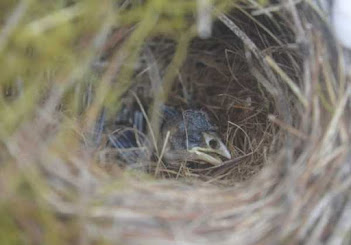 |
| Darwin's Finch chick in nest on the Galapagos Islands. Credit: A Katsis, Flinders University |
A new study, published in Proceedings of the Royal Society B, has found evidence Darwin’s finch females that spend longer inside the nest can ward off deadly larvae of the introduced avian vampire fly, which otherwise enter and consume the growing chicks.
The maternal buffer is a life-saver, according to the research, especially during the first days after hatching, when chicks are blind, helpless and cannot preen. Although older offspring still have to contend with the larvae, they are better able to preen themselves, and may dislodge and occasionally eat some of them.
“The pair male is also essential for success of the chicks. If he feeds the offspring a lot, the mother can remain inside the nest for longer,” says Flinders University Professor Sonia Kleindorfer, who is also affiliated with the University of Vienna.
“Timing is everything. The female must forgo foraging herself, and her persistence is strongly influenced by good food provisioning of her offspring by the male.”
The unintentionally introduced avian vampire fly, an invasive species on the Galápagos Islands, enters Darwin’s finch nests when attending parents are absent.
The 17 Darwin’s finch species on the Galápagos Islands are a textbook example of a rapid adaptive radiation: each species has a unique beak shape suited to extract resources from a different ecological niche. However, since being first observed in Darwin’s finch nests in 1997, the avian vampire fly has been parasitizing nestlings and changing the beak and behavior of its Darwin’s finch hosts.
The fly lays eggs that hatch into larvae that feed on the developing chicks, killing most chicks and causing beak deformation in the survivors.
“What we show in this publication is that longer female in-nest attendance of chicks predicts the number of parasites in the nest,” says Professor Kleindorfer.
“The new research findings are significant because they show that ‘just being there’ can be a form of front-line defense against threats to offspring survival.”
British naturalist Charles Darwin’s theory of evolution by natural selection was developed while observing plants and animals in various environments, including the Galápagos Islands, where in 1835 he noted the rich diversity of endemic plants, birds and reptiles.
Female Darwin’s finches provide much longer in-nest care to young offspring than males, and presence inside the nest is needed to fend off parasites. For this reason, females themselves may incur higher survival costs as they attempt to save their offspring.
Monitoring survivorship of female birds is often more difficult than for males since male Darwin’s finches produce a loud advertisement song but females to not.
Usually we think of active defending males as contributing more to offspring survival than females that incubate eggs or brood young chicks, adds Flinders University researcher Dr Andrew Katsis.
“We know from long-term monitoring of Darwin’s finches, from recapture and resighting data since 2000, that annual survivorship in females is much lower than in males, and over 50% of male Darwin’s finches sing at the nest but don’t attract a female,” he says.
“Combined, these factors suggest that higher female mortality, and higher parental care costs carried by females, may be a contributing factor.”
High-quality females that can sustain longer in-nest parental care with less feeding opportunity for themselves, paired with males that increase feeding to the offspring, have better chances to produce offspring in a vampire fly-dominated environment, the research concludes.
“Control measures are urgently needed to save Darwin’s finches from extinction,” the scientists say in another new publication in Birds.
They found only 10.4% of the critically endangered Medium Tree Finch nests produced young on Floreana Island, and the rest were killed by either predators or the parasites.
Source/Credit: Flinders University
bio121621_01







.jpg)